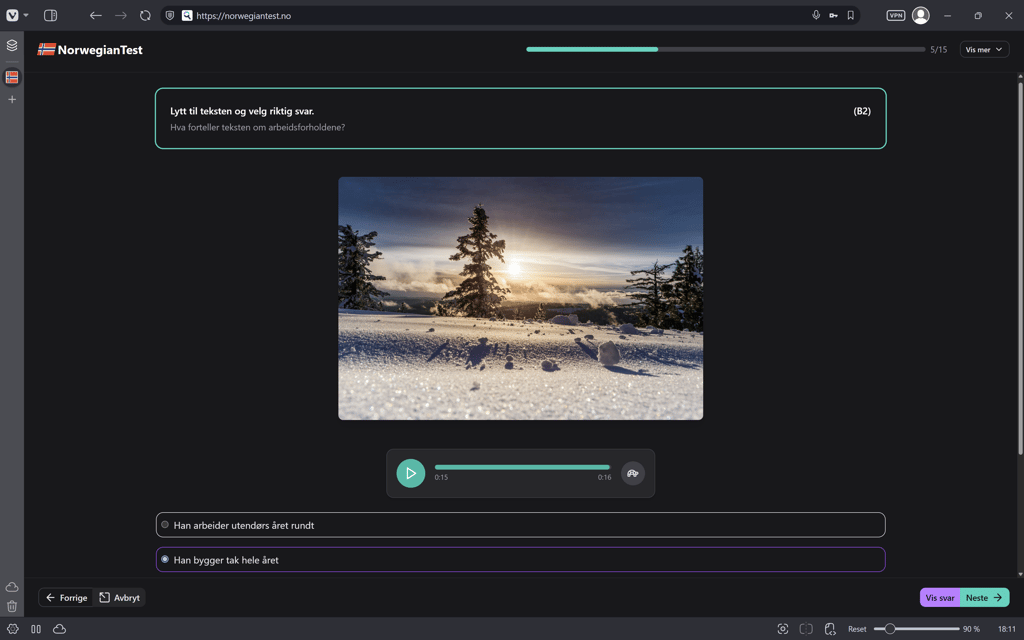About Norway - Cultural Background for the Norwegian Test A1-B2
About Norway: Cultural Background for the Norwegian Test A1-B2
Why is knowledge about Norway important for the Norwegian test?
Understanding Norway as a society, culture, and nation can be useful for succeeding on the Norwegian test A1-B2. The Norwegian test primarily evaluates language skills – your ability to understand, speak, read, and write Norwegian. However, knowledge about Norwegian culture and society can help you understand the context in texts and conversations used on the test.
Candidates who have good knowledge about Norway and Norwegian culture may find it easier to understand cultural references and context in the language tasks on the Norwegian test, even though the test primarily measures language skills.
Knowledge about Norway helps you with:
- Text comprehension: Understand references to Norwegian places, people, and events
- Cultural context: Interpret implicit messages in Norwegian texts
- Conversation topics: Participate actively in discussions about Norwegian conditions
- Writing tasks: Use relevant examples from Norwegian society
- Self-confidence: Feel more secure about Norwegian culture and values
Norway's Geography and Regions
Basic Geography
Norway is an elongated country in Northern Europe with:
- Area: 385,207 km² (including Svalbard and Jan Mayen)
- Population: Approximately 5.5 million inhabitants
- Capital: Oslo (approximately 700,000 inhabitants)
- Length: Over 1,750 km from south to north
- Borders: Sweden, Finland, and Russia
- Coastline: Over 25,000 km with fjords
The Five Regions
Eastern Norway (Østlandet)
Important cities: Oslo, Drammen, Fredrikstad, Hamar, Lillehammer
- Norway's most populated region
- Economic and political center
- Inland areas with forests and lakes
- Key industries: technology, finance, public sector
Western Norway (Vestlandet)
Important cities: Bergen, Stavanger, Haugesund, Ålesund
- Known for spectacular fjords
- Oil capital Stavanger
- Fishing and maritime traditions
- Rainy climate
Central Norway (Trøndelag)
Important cities: Trondheim, Steinkjer
- Historical capital with Nidaros Cathedral
- NTNU – important university
- Agriculture and technology
- Central location in Norway
Northern Norway (Nord-Norge)
Important cities: Tromsø, Bodø, Alta, Hammerfest
- Midnight sun and northern lights
- Sami culture and language
- Fishing and tourism
- Challenging climate
Southern Norway (Sørlandet)
Important cities: Kristiansand, Arendal, Mandal
- Popular vacation destination for Norwegians
- White sandy beaches
- Summer climate
- Traditional wooden towns
Norwegian History – Important Periods
Viking Age (793–1066)
- Norwegian Vikings explored and traded in Europe
- Viking ships and seafaring
- Important kings: Harald Fairhair, Olav the Holy
- Christianization of Norway
Union with Denmark (1380–1814)
- Norway in union with Denmark for over 400 years
- Copenhagen as capital
- Danish as written language
- Reformation and Lutheran Christianity
Union with Sweden (1814–1905)
- Own constitution at Eidsvoll
- National romanticism and identity
- Development of Norwegian culture and language
- Parliamentarism and democracy
Modern Norway (1905–present)
- Independence and own king
- Neutrality in World War I
- Occupation during World War II
- NATO membership (1949)
- Oil discovery in North Sea (1969)
- EU referendums (1972, 1994)
Norwegian Society
Political System
Form of government: Constitutional monarchy
- King: Harald V (head of state)
- Prime Minister: Leads the government
- Storting: National assembly with 169 representatives
- Constitution: From 1814, world's second oldest
Welfare State and Values
The Norwegian Model:
- Universal welfare services
- Free healthcare and education
- Strong trade unions
- High degree of equality
- Low degree of inequality
Core values:
- Solidarity: Community and support for vulnerable groups
- Equality: Between genders, classes, and groups
- Justice: Equal treatment and opportunities
- Trust: High trust in institutions and fellow humans
- Consensus: Seeking broad agreements rather than confrontation
Norwegian Culture and Traditions
Holidays and Celebrations
National Holidays
- May 17: Constitution Day – Norway’s national day
- June 23: Midsummer Eve (St. Hans)
- December 25: Christmas Day
Christian Holidays
- Easter: Major holiday with cabin trips
- Whitsun (Pentecost): Traditional confirmation time
- Christmas: Most important holiday with family gatherings
Outdoor Life and Nature
The Right to Roam (Allemannsretten):
- Right to free movement in nature
- Free access to forests and fields
- Responsibility not to harm nature
- Respect for private property and wildlife
Popular Activities:
- Skiing: National sport – cross-country and alpine
- Football: Most popular team sport
- Cabin life: Cabins in the mountains or by the sea
- Fishing: Both sea and freshwater fishing
- Hiking: Mountain hikes
Food and Culinary Culture
Traditional Norwegian Food
- Fish: Salmon, cod, herring – important part of the diet
- Meat: Reindeer, moose, sheep
- Potatoes: Main source of starch
- Bread: Coarse bread and crispbread
Typical Norwegian Dishes
- Fårikål: National dish with lamb and cabbage
- Rakfisk: Fermented fish
- Lutefisk: Dried fish treated with lye
- Lefse: Traditional flatbread
- Rømmegrøt: Creamy porridge
Modern Food Culture
- Organic and sustainable food: Gaining popularity
- International cuisine: Influences from all over the world
- Coffee culture: Norwegians drink a lot of coffee, often socially
Tags:
NORWAYNORWEGIAN CULTURENORWEGIAN TESTSOCIAL STUDIESNORWEGIAN HISTORYGEOGRAPHYTRADITIONSVALUESCULTURAL UNDERSTANDINGPractice for FREE!

